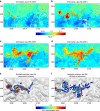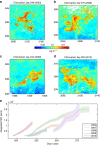Dispersion/dilution enhances phytoplankton blooms in low-nutrient waters
- PMID: 28361926
- PMCID: PMC5380962
- DOI: 10.1038/ncomms14868
Dispersion/dilution enhances phytoplankton blooms in low-nutrient waters
Abstract
Spatial characteristics of phytoplankton blooms often reflect the horizontal transport properties of the oceanic turbulent flow in which they are embedded. Classically, bloom response to horizontal stirring is regarded in terms of generation of patchiness following large-scale bloom initiation. Here, using satellite observations from the North Pacific Subtropical Gyre and a simple ecosystem model, we show that the opposite scenario of turbulence dispersing and diluting fine-scale (∼1-100 km) nutrient-enriched water patches has the critical effect of regulating the dynamics of nutrients-phytoplankton-zooplankton ecosystems and enhancing accumulation of photosynthetic biomass in low-nutrient oceanic environments. A key factor in determining ecological and biogeochemical consequences of turbulent stirring is the horizontal dilution rate, which depends on the effective eddy diffusivity and surface area of the enriched patches. Implementation of the notion of horizontal dilution rate explains quantitatively plankton response to turbulence and improves our ability to represent ecological and biogeochemical processes in oligotrophic oceans.
Conflict of interest statement
The authors declare no competing financial interests.
Figures




References
-
- Field C. B., Behrenfeld M. J., Randerson J. T. & Falkowski P. Primary production of the biosphere: integrating terrestrial and oceanic components. Science 281, 237–240 (1998). - PubMed
-
- Riley G. A. Factors controlling phytoplankton populations on Georges Bank. J. Marine Res. 6, 54–73 (1946).
-
- Abraham E. R. et al.. Importance of stirring in the development of an iron-fertilized phytoplankton bloom. Nature 407, 727–730 (2000). - PubMed
-
- Martin A. P. Phytoplankton patchiness: the role of lateral stirring and mixing. Prog. Oceanogr. 57, 125–174 (2003).
-
- Lehahn Y., d'Ovidio F., Lévy M. & Heifetz E. Stirring of the northeast Atlantic spring bloom: a Lagrangian analysis based on multi-satellite data. J. Geophys. Res. 112, C08005 (2007).
Publication types
MeSH terms
Substances
LinkOut - more resources
Full Text Sources
Other Literature Sources

